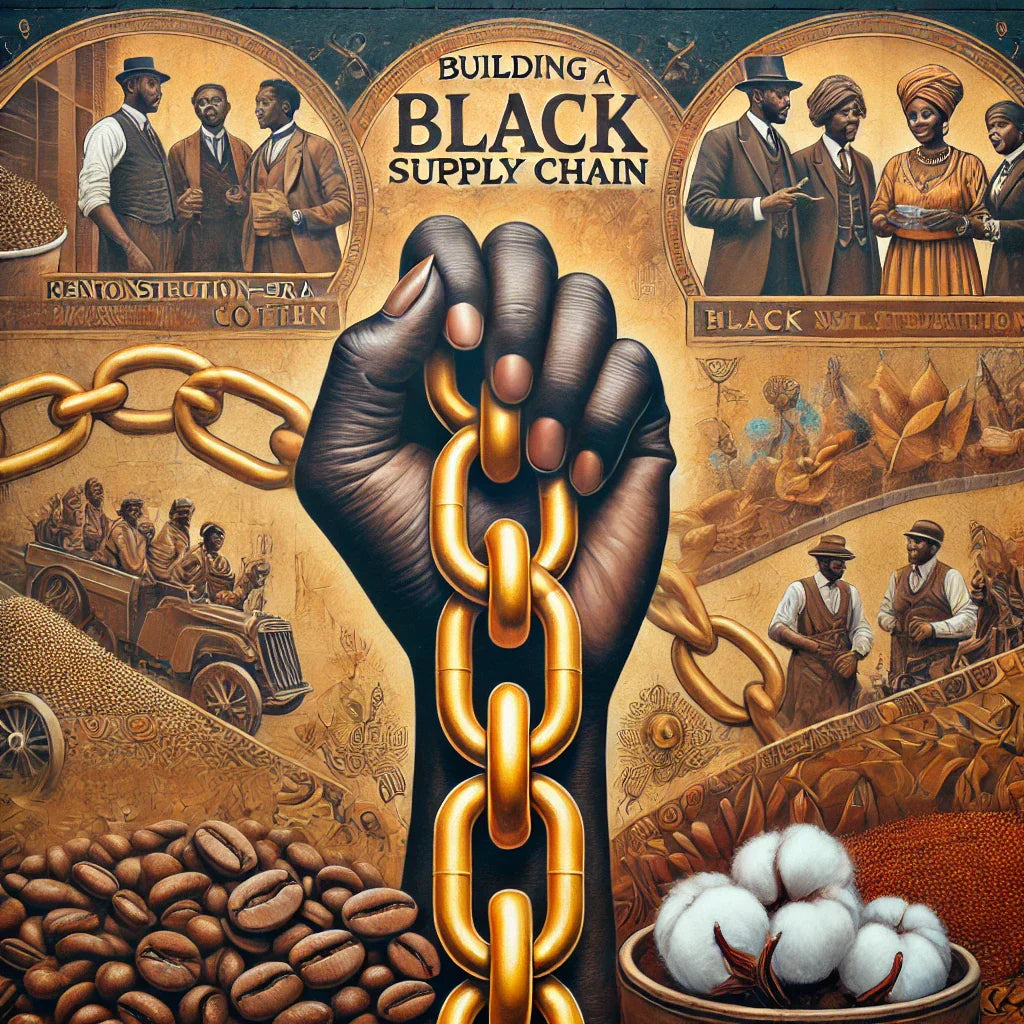
Building a Black supply chain isn’t just about finding vendors—it’s about building a whole new way of doing business. From sourcing new importers, vendors, and capital to getting mentors to front us the money so we can work with traders who don’t have the capital to offer terms, to even importing the coffee ourselves when all else fails—it’s a constant process of iteration. We’re committed to having 100% participation in our supply chain by 2035. But in the meantime, as we build it, here’s what we’ve learned.
1. It’s Going to Take Longer
If you’ve spent your life operating within the instant-gratification machine of modern supply chains, prepare to unlearn that convenience. Working within a Black supply chain means working with vendors who often have less infrastructure, fewer resources, and less inventory on hand. They don’t have the luxury of mass production or warehouses stocked with surplus—they produce what they can, when they can, with the resources available.
Colonial supply chains had a 400-year head start. Generations of government subsidies, free labor, and stolen land have created a well-oiled machine where you can press a button and have something at your doorstep in 48 hours. That’s not our reality.
But here’s the thing: waiting isn’t just an inconvenience. It’s a mindset shift. It forces you to be intentional about what you consume, to respect the process, and to recognize the value of labor. And when that product finally arrives, you know exactly who made it, how they made it, and why it matters.
It also means that instead of chasing the latest trends, you have to focus on craft and customer care.When you can’t pivot instantly to whatever is hot this month, you have to double down on what makes your product excellent. You have to educate your customers on why it’s worth waiting for, why quality matters, and why true sustainability isn’t just about the environment—it’s about economic sustainability for the people making what you consume.
2. There’s Less Variety, but More Depth
Another reality of working in a Black supply chain is that you don’t have endless options. If you’re sourcing coffee, for example, you can’t just scroll through a massive catalog and pick whatever you want from wherever you want. You’re working with what exists—and sometimes that means you’re working with fewer suppliers, fewer processing methods, and fewer pre-established systems.
But here’s what people don’t tell you: fewer options often mean higher quality. When you work within a Black supply chain, you’re dealing with artisans, not assembly lines. You’re talking directly to the farmer, the exporter, the roaster—people who are hands-on with every step of the process. There’s less mass production and more craftsmanship. Less generic, more boutique.
Yes, it takes time to build the variety, but what you lose in breadth, you gain in depth. And depth is where real excellence lives.
3. It’s Going to Cost More (And That’s the Point)
It’s going to cost you more money—and not just more money, but money up front.
This is the part that stops most people in their tracks. Why? Because the companies that dominate global supply chains have been given every financial advantage possible—access to massive lines of credit, investment capital, and decades of profits reinvested to keep their costs low. Meanwhile, many Black suppliers don’t have the luxury of net-30 or net-60 terms. They can’t afford to send you inventory and wait months for payment. They need that cash flow immediately to keep their businesses alive.
This means as a buyer, you have to be creative. You might have to prepay for inventory. You might have to negotiate different financial arrangements. And you might have to educate your customers on why your product costs what it does.
But here’s the truth: this is the cost of liberation.
This is the same cost our ancestors paid during Reconstruction when they built the first Black business trade networks from nothing. This is the same cost Black Wall Street paid, where entire communities came together to build their own economies—before they were burned down.
Every time we started to invest in our own economic independence, the system found a way to make us pay. Not just with money, but with destruction.
But here we are.
Another generation. Another opportunity.
This time, we build with the lessons of the past in mind. This time, we build knowing that our work is not just about us, but about creating something our children can inherit. This time, we build chains of freedom.
Invest in the Future of Black Supply Chains
You only have a few days left to invest. Check out our crowdfunding equity opportunity on WeFunder. We’re giving our community a chance to own a piece of this movement through a revenue share opportunity.
And for the next 25 investors who invest $1,000 or more, we’re offering something truly special—a limited edition collaboration with Komoko Cotton, the world’s first all-Black cotton supply chain, owned by Steven Satterfield of Netflix’s High on the Hog and Whetstone Media.
Because this isn’t just about coffee. This is about reclaiming everything.

